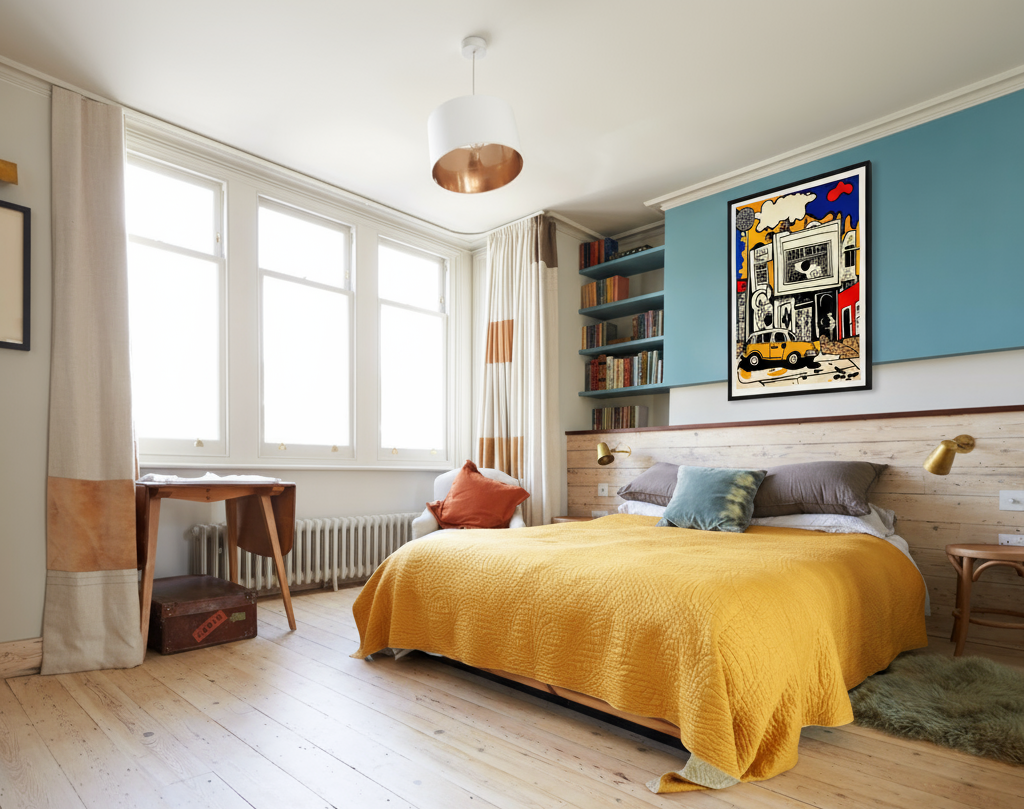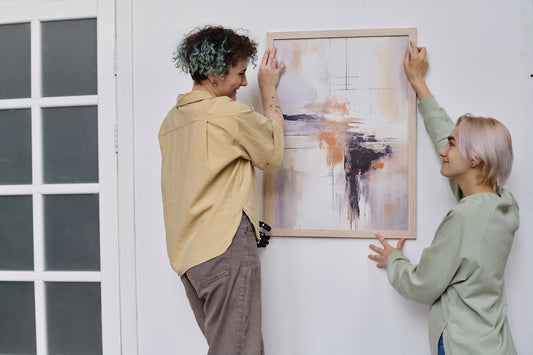
How to Choose Wall Art for Small Spaces: Maximizing Impact Without Clutter
Love art but worry about overcrowding your compact room? Learn how to choose wall art that makes walls feel larger, your room more vibrant, and adds personality without overwhelming your space. These strategies work perfectly for placing art in small spaces like apartments, studios, or compact homes.
In this blog, you’ll learn:
- Picking the right art size
- Using color to open your space
- Creative ways to display art
- Hanging art without clutter
- Mistakes to avoid for balance
Why Wall Art is Non-Negotiable in Small Spaces
Art converts cramped rooms into intentional sanctuaries. Strategic wall pieces serve as emotional anchors that detract from the limited square footage of small spaces. These frequently lack architectural complexity, and careful selection can give the appearance of space. Plus, you inject your personality into it.
Consider two psychological effects of art. First, art generates focal points, pulling eyes away from room boundaries. Second, textures alter spatial perception significantly. Let’s find out why decorating small rooms with art is essential.
Visually Expand the Room
Art wields optical illusions better than furniture. When placed thoughtfully, it extends sightlines and redirects the eye. Horizontal art broadens walls visually, while vertical pieces lift your gaze toward the ceiling. Either strategy can enhance spatial perception, depending on your room shape.
A small room achieves visual openness through non-directional textures. Think linen canvas, matte prints, or soft fiber art. These don’t add interruption to your line of sight, creating a limiting feel.
Mirrors provide an excellent method to expand a space’s appearance, simply by performing their primary function: creating reflections. This amplifies the visual perception, making it appear as though you have additional space.
However, shiny surfaces, like mirrors, polished metals, or glossy frames, create glare hotspots, creating a close-up feel. The key is to strike a balance between tactile feel and visual expansion through reflection.
Emotional Impact in Compact Living
Beyond appearances, art influences mood. Minimalist art ideas can evoke a feeling of calmness, which benefits spaces like bathrooms and bedrooms. Conversely, vibrant images and bright hues incite interest, making them great as conversation pieces in living rooms.
This highlights why selecting pieces carefully matters. Relaxation results from cool tones such as muted blues, soft grays, and pastel hues, whereas warm tones like reds and oranges increase energy.
Art also generates emotional grounding, providing spaces with a feeling of intention and personalization. Even one thoughtful piece shifts perception. That clarity makes daily living environments more uplifting, regardless of space limitations.
Create Better Flexibility
When done right, you are creating a more flexible collection of decor. You can remove and install certain pieces depending on the season, the theme of your life’s journey, and milestones. Plus, the strategic use of colors, reflective surfaces, and tactile textures creates a perfect blend of personalization for your space.
How to Choose Wall Art for Small Spaces: Step-by-Step Guide
Strategy plays a role in decorating, especially in limited spaces. Here’s your guide on how to choose wall art the right way.
Step 1: Choosing the Right Art Size

Scale rules your space’s harmony. You want your art to cover only 30% to 40% of the wall. So, a 12-foot wall can benefit from a three- to four-foot piece.
Think about ceiling height, as well. In low-ceiling rooms, horizontal art feels more stable without drawing gaze upward too much. Taller rooms can accommodate vertical formats that accentuate height.
Aside from these, consider furniture relationships. A key artwork size guide is to leave around six to eight inches above furniture, spanning 50% to 75% of the sofa’s width for visual cohesion.
For more in-depth guidance, check out these helpful tools and articles:
- How to Measure Your Wall to Get the Right Size Art
- How to Space Pictures on a Wall When Mixing Sizes
Step 2: Selecting Art Media That Work

Your chosen medium shapes visual space. Canvas and paper prints appear light, while framed art with floating mounts adds subtle depth.
Frame types can even help you achieve a desired effect. Bold, thick frames command attention, while slender ones whisper sleek sophistication. Ornate designs drape your space in luxury, whereas minimalist frames offer modern simplicity.
Textile art involving cotton and linen tapestries provides gentle warmth and softness. Wall sculptures intrigue with their dimensional charm, all without stealing precious floor real estate like standing pieces do.
The key is to balance the volume of the art with the space you have. If you have a more elongated space, adding standing art can crowd the room. This situation makes hanging art a better choice.
Step 3: Color, Contrast, & Theme Strategies

Choose a primary palette. Pick two gentle colors and one accent color to achieve balance. For instance, soft ray and blush create a soothing foundation, while vibrant teal brings energy.
Use this color combination throughout different areas of the space for uniformity. However, remember to pair complementary colors to bring interest and not overwhelm. Avoid excessive contrast, as well. This can make this move feel too overpowering.
Nevertheless, theme continuity still matters. For serene bedroom options, nature-themed prints or minimalist art keep a restful aura. Busy decor demands neutral art, just like neutral furniture requires bold prints.
Speaking of decor, a crucial technique in choosing colors in art is to match art to existing decor by sampling paint-coded swatches or creating digital mockups.
Creative Display Techniques for Small Spaces

Once you have selected the right pieces, your next step is designing the layout. Not sure how to start? Here are creative options you should try:
Gallery Walls vs Solo Statements
A gallery wall in studio setups can be impactful when limited to five to seven pieces in matching frames with three to five inches of spacing between them. This creates unity and elegance.
Solo statements, like painting in square formats, can dramatically open a space. Positioned as a central piece above big furniture, this piece creates a singular focus to simplify the decor and increase intentionality.
Unconventional Methods to Maximize Space
Here are some concepts you can leverage to maximize what little space you have:
- Vertical Space
Use tall vertical pieces or lean frames against a wall. That draws vision from floor to ceiling, making spaces feel taller.
- Depth and Dimension
Try picture rails for layering smaller prints beneath a primary piece. Place a slender mirror or metallic sculpture behind the first pieces to amplify depth with reflections.
- Rule-Breaking Arrangements
Mix sizes and orientations in asymmetrical layouts. For example, one large abstract with two smaller portraits around a tall plant. That creates visual flow without rigid grid lines.
- Flexible Displays
Floating shelves with clips let you rotate prints seasonally. Canvas-backed art hung by easy hooks without drilling suits renter-friendly refresh cycles. Adding greenery can also soften art edges and is easy to move around when rearranging.
Embrace Modernity
Art has evolved throughout the decades, so there’s nothing wrong with incorporating technology. Digital art prints are great examples of this, as they give more people access to beautiful masterpieces.
For a more technology-focused choice, digital frames excel at showcasing high-resolution images of artwork, photos, and additional pieces, perfect for art room ideas for small spaces.
Top 5 Common Mistakes to Avoid
You know what to do, but what’s not to do? Make sure to avoid these common decorating mistakes:
Mistake 1: Too Many Small or Oversized Pieces
Clustering too many small frames can create a sense of fragmentation in the visual flow. Big canvases can overpower low-ceilinged rooms. Balance scale thoughtfully, anchored by size patterns.
Mistake 2: Wrong Colors or Lighting
Deep hues close in with warmth but shrink visually. Base art and furniture in light palettes, then layer accent bulbs on the artwork. Use directional accent lamps to enhance, not hide art.
Mistake 3: Poor Height or Background Choices
Art that’s too high loses eye contact, while too low feels cramped. Avoid busy wallpaper where art hangs. Go for plain or subtly textured backgrounds to enhance the art breathing space.
Mistake 4: Bulky Materials
Thick molding and heavy textures visually anchor and weigh down a wall. Simple canvases or light frames work better to preserve space and openness. That said, while mirrors create a sense of expansiveness, limit their use to one strategic piece. Remember, multiple reflections crowd rooms.
Mistake 5: Ignoring Room Shape
High ceilings need proportion-lowering elements like tall drapes or shelving. Narrow rooms demand emphasis on far walls. Make sure you pick rugs, art, and lighting that draw viewers inward and break monotony.
Where to Shop for Wall Art that Fits Small Spaces
Start by exploring different sources for wall art that fits small spaces. Thrift shops and flea markets often have preloved pieces. A new frame can even add character without adding bulk or cost. That said, give your local frame shop a look. They occasionally offer discounted prints or sample canvases that match your style preferences.
When choosing the budget-conscious approach, the DIY method can assist you in producing art using supplies you currently possess. Spare ornamental textiles or dried flowers can add texture and personal flair to your home.
Buying wall prints online also offers an easy way to decorate small rooms. You have a vast variety of choices, themes, color palettes, and styles. This makes it easier for you to customize the place with maximum options with minimum effort.
When budgeting, include framing and shipping costs. Many stores offer bundled deals to make this easier. Whether you prefer local finds or online convenience, combining both ensures your small space gets art that fits without clutter.
Art Decor for Small Spaces Pro Tips
For an easier time decorating your small home, these important art placement tips wrap it all together:
| Who’s Decorating? | Decor Tips |
| Renters | Choose wall prints that won’t damage walls or require nails. Use removable hooks or adhesive strips, as well as lightweight prints that can be moved easily. |
| Homeowners | You have more freedom to hang larger or heavier pieces. Invest in quality framing to match your decor. Consider statement prints or gallery walls that enhance living rooms or hallways with a lasting impact |
| Studio Apartment Dwellers | Use versatile wall art ideas like multi-purpose prints or foldable pieces. Gallery walls in studios maximize vertical space and create style without taking up floor space. |
| Remote Workers | For home offices, select motivational or inspiring prints to boost productivity. Bright colors or bold contrasts can energize. Hanging art in small spaces here should balance focus and creativity without clutter. |
| Kids and Kids-at-Heart | Go for playful, colorful prints that grow with your child. Easy-to-clean frames and lightweight options work best. For hobbyists, pieces that go with the theme of your hobby are great starting points. |
Frequently Asked Questions
Still have questions about decorating your small space with art? Check this out:
What size wall art is best for a small living room?
Follow the ⅓ to ¼ rule to leave breathing room between the art and furniture, ideally with a six- to eight-inch gap.
How do I hang art without making a small room feel cluttered?
Keep three to five inches of spacing between frames at eye level.
Can large art pieces work in a small space?
Definitely! One large canvas simplifies and clarifies the room’s focus. Just ensure the scale fits the ceiling height and wall dimensions.
What kind of art is best for small bedrooms?
Opt for calming abstracts, soft landscapes, or pastel textiles for a relaxing vibe.
How do I choose colors for wall art in a compact area?
The key is to identify a theme or function. Aside from relaxing tones and styles for bedrooms, you can go for eccentric pieces for living and working areas. Light backgrounds also open up the space.
What media work for limited spaces?
Different art mediums could work for any space, as long as you install them strategically. If you are low on floor estate, stay away from standing sculptures and opt for hanging pieces. For limited wall space, smaller framed art and mini standing pieces could work.
Transform Your Small Space with Wall Art
Ready to transform your compact space? Explore diverse small space wall art ideas to make every inch of your place count.



